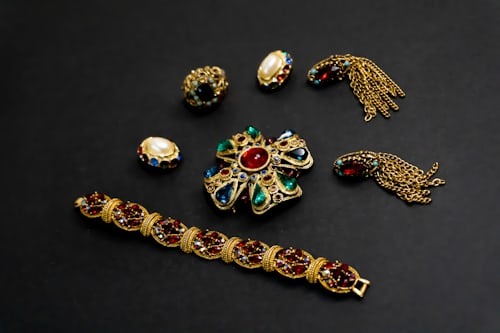Jewelry-making is an art that has evolved through centuries, blending tradition with innovation. Cooper jewelry stands out for its distinct craftsmanship, durability, and artistic appeal. Whether used in statement pieces or delicate designs, this jewelry showcases the versatility of metalworking techniques. From ancient methods to modern advancements, the craftsmanship behind cooper jewelry continues to inspire both collectors and artisans.
The Origins and Legacy of Cooper Jewelry
Cooper jewelry has a rich history that dates back to ancient civilizations. This metal was widely used by early craftsmen due to its malleability and ability to develop a unique patina over time. Many historical artifacts, including rings, bracelets, and amulets, were crafted using cooper, showcasing the expertise of early metalworkers.
In various cultures, this jewelry symbolized status, protection, and artistic expression. The Egyptians, Greeks, and Romans incorporated cooper into their adornments, embedding gemstones and intricate engravings. Over time, the craftsmanship of it evolved, adapting to different artistic movements and technological advancements.
Traditional Techniques in Cooper Jewelry Making
The creation of cooper jewelry involves a series of intricate steps, each requiring skill and precision. Many traditional techniques are still used by artisans to maintain the authenticity and quality of handcrafted pieces.
Hand Forging and Hammering
One of the oldest techniques in metalworking, hand forging involves heating cooper and shaping it with hammers and anvils. This method allows artisans to create unique textures and patterns, giving each piece a distinctive look. Hammering further enhances the design by adding depth and character to the jewelry.
Engraving and Etching
Engraving and etching techniques add intricate details to cooper jewelry. Hand engraving requires precision tools to carve delicate patterns, initials, or symbols into the metal. Etching, on the other hand, involves the use of acids to create artistic designs on the jewelry surface. Both methods enhance the visual appeal and uniqueness of each piece.
Patina and Oxidation
Cooper naturally develops a patina over time, which enhances its aesthetic value. Many artisans use controlled oxidation techniques to create different shades of green, blue, or brown on cooper jewelry. This process gives the jewelry an antique and artistic finish, making each piece a one-of-a-kind masterpiece.
Modern Innovations in Cooper Jewelry Design
With advancements in technology, the art of cooper jewelry making has expanded beyond traditional methods. Modern jewelers incorporate innovative techniques to enhance durability, aesthetics, and functionality.
Electroforming for Precision Designs
Electroforming is a technique that allows jewelers to create lightweight yet intricate cooper jewelry pieces. This process involves depositing metal onto a mold using electrical currents, ensuring precise detailing and uniform thickness. Electroformed this jewelry is widely used in contemporary fashion for its sleek and lightweight properties.
Laser Cutting and Engraving
Laser technology has revolutionized cooper jewelry design by enabling highly detailed engravings and precision cuts. This method is ideal for creating intricate filigree patterns, geometric shapes, and personalized engravings without affecting the structural integrity of the jewelry.
Mixed Metal Combinations
Modern designers experiment with cooper by blending it with other metals such as silver, gold, and brass. These combinations enhance the strength and aesthetic appeal of jewelry pieces. Cooper-silver alloys, for instance, are widely used in statement jewelry to create contrast and sophistication.
Identifying Authentic Cooper Jewelry
As cooper jewelry gains popularity, distinguishing authentic pieces from imitations becomes essential. Buyers and collectors should consider various factors when assessing the quality and authenticity.
Checking Hallmarks and Stamps
Genuine jewelry often comes with hallmarks or stamps indicating purity and authenticity. These markings help buyers verify the metal composition and craftsmanship of the piece. It is advisable to research hallmark standards before purchasing.
Assessing the Weight and Finish
Authentic jewelry has a distinctive weight and finish. High-quality pieces feel substantial, with smooth edges and refined craftsmanship. Jewelry with uneven surfaces or lightweight properties may indicate inferior quality or mixed alloys.
Observing Patina Development
One of the unique characteristics of this jewelry is its ability to develop a natural patina over time. Genuine cooper pieces exhibit gradual color changes, whereas fake or coated jewelry may fade or peel unevenly. Observing the aging process can help determine authenticity.
How to Maintain and Preserve Cooper Jewelry
Proper care is essential to maintain the beauty and longevity of this jewelry. Exposure to moisture, chemicals, and air can affect its appearance over time. Following the right maintenance practices ensures that cooper jewelry remains in excellent condition.
Regular Cleaning with Natural Solutions
To prevent tarnish and oxidation, this jewelry should be cleaned regularly. A mixture of lemon juice and baking soda can help remove tarnish without damaging the metal. Using a soft cloth to polish the jewelry restores its shine and removes surface impurities.
Proper Storage Techniques
Storing cooper jewelry in a dry, airtight container prevents oxidation and patina buildup. Anti-tarnish cloth or silica gel packets can help absorb moisture, keeping the jewelry in pristine condition. Avoid exposing cooper jewelry to direct sunlight or humid environments.
Avoiding Chemical Exposure
Household chemicals, perfumes, and lotions can accelerate tarnishing in this jewelry. It is advisable to remove jewelry before applying cosmetics or engaging in activities that involve chemical exposure. Cleaning the jewelry after wear helps preserve its original luster.
The Future of Cooper Jewelry Craftsmanship
The demand for sustainable and handcrafted jewelry continues to grow, influencing the future of this jewelry craftsmanship. Artisans and designers are exploring eco-friendly methods, ethical sourcing, and innovative designs to meet modern consumer preferences.
Ethical Sourcing and Sustainability
With a growing focus on sustainability, many jewelers are sourcing cooper from recycled and ethically mined materials. This approach reduces environmental impact while supporting responsible mining practices. Sustainable jewelry appeals to eco-conscious buyers seeking ethical fashion choices.
3D Printing in Jewelry Design
The integration of 3D printing technology in jewelry making allows for intricate and customized cooper jewelry designs. This innovation enables designers to create complex patterns and shapes that were once difficult to achieve using traditional methods.
Personalized and Custom Jewelry Trends
The trend of personalized cooper jewelry is gaining popularity, with customers seeking unique and customized pieces. Engraving names, initials, or meaningful symbols on this jewelry adds sentimental value, making each piece a cherished possession.
Final Thoughts on Cooper Jewelry Craftsmanship
The craftsmanship of cooper jewelry reflects a blend of tradition, artistry, and modern innovation. From ancient hand-forging techniques to cutting-edge 3D printing, this jewelry remains a timeless expression of creativity. Whether appreciated for its rich history, unique patina, or contemporary appeal, it continues to captivate jewelry enthusiasts and collectors worldwide.








